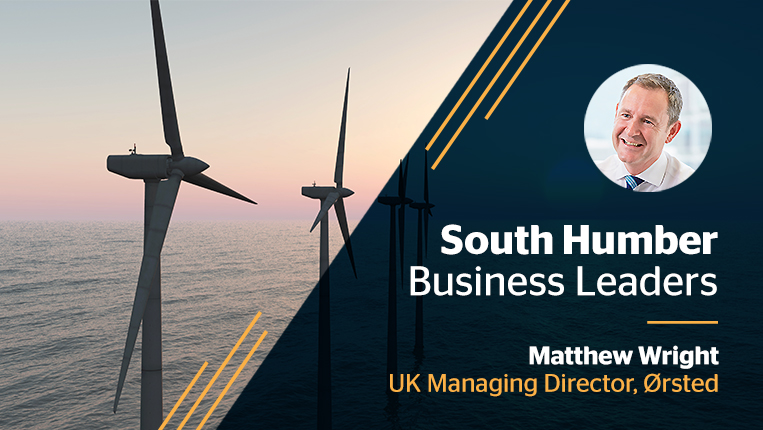Building ‘the World’s First Offshore Wind Cluster’ – An Interview with Matthew Wright, UK Managing Director, Ørsted
4:24 pm, Wednesday, 1st May 2019 - 5 years ago

Matthew Wright is the UK MD for Ørsted, the Danish renewable energy company which is currently developing the world’s largest offshore wind farms off the Humber estuary.
Why is the Humber, and particularly Grimsby, emerging as such an important location for the UK’s offshore wind sector?
Globally the North Sea is the best place to build offshore wind farms because of the shallow water and high wind speeds. The Humber is central on the east coast – the estuary has a maritime history and appropriate port facilities, which makes it an ideal location for the offshore wind industry.
Because of its location at the mouth of the estuary and its existing capability to service offshore activities, Grimsby was the obvious choice for our Operations and Maintenance (O&M) base.
What has been the scope of Ørsted’s investment in the area and what else is planned?
Ørsted has been directly involved in the Humber since 2013, when it opened a modest construction base at the Port of Grimsby and began building the multi-million pound O&M base at the Royal Dock. This is currently being extended to become our East Coast Hub – the largest facility of its kind in the UK and possibly the world. This £10 million build is being undertaken by a local contractor – Hobson and Porter – and it will centralise the O&M activities for our wind farms in the North Sea.
Our direct investment in Grimsby is in these facilities and the local supply chain. However, if you add the investment offshore it amounts to billions of pounds. Westermost Rough and Race Bank wind farms are already operated from Grimsby. Hornsea 1 is under construction, Hornsea 2 is in very advanced planning stages and will begin construction soon. At 1.2 GW, Hornsea 1 will take the title of the world’s largest offshore wind farm for a time and will then be superseded by Hornsea 2, which will be nearly 1.4 GW.
How is the Port of Grimsby offshore renewables O&M cluster developing, and what are its specific capabilities?
As home to our O&M facility Grimsby is particularly important, and it features in several UK and world firsts that are being developed off the east coast. The first Service Operations Vessel (SOV) for an offshore wind farm operates from Grimsby. Workers who are constructing and maintaining the wind farm live and work from the vessel for 2 weeks at a time.
The nearby University of Hull is home to the Offshore Renewable Energy (ORE) Catapult’s O&M Centre of Excellence. Research projects include how to improve the use of Remote Operations Vehicles (ROVs), the use of artificial intelligence, innovation in the design of crew transfer vessels (and other vehicles used to access turbines), and improving maintenance practices whilst minimising interruption to power supply from the farms.
And how is the offshore renewables cluster developing in the wider Humber region?
The Humber region is developing into what I would say is the world’s first offshore wind cluster. The area’s manufacturing capabilities include a large OEM – the Siemens Gamesa blade factory in Hull is extremely significant to the local economy. Our Racebank project was the first to use these blades and the Hornsea projects will also use blades manufactured in the Humber.
Siemens Gamesa have built state-of-the-art training facilities and companies can access other local training providers – Grimsby Institute in particular. We have links with local universities, innovation through the ORE Catapult and strong support from local government. The cluster’s association with the Local Enterprise Partnership (LEP) is really strong – lots of organisations are coordinating and collaborating to make the area a real hub for Offshore Wind.
In many respects, what is happening in the Humber is a blueprint for what can happen elsewhere in the UK and the rest of the world. Every six months we have delegations from around the world, wanting to look at how Offshore Wind is helping to regenerate the region.
What does the future hold for the Port of Grimsby and the Humber as a UK centre for offshore renewable energy?
The North Sea has enormous potential for offshore wind so the future is really bright. There is a project pipeline – as well as Hornsea 1 and 2, Hornsea 3 is going through planning and there are outline plans for Hornsea 4. This leads to economies of scale and the clustering effect of building adjacent projects – which means that you can share facilities and services such as ports and vessels. The critical mass is already there. That really puts Grimsby and the Humber in a very strong position to compete for new projects, which we’d be delighted to see.
As for Ørsted, we’ve been made to feel extremely welcome in Grimsby and the Humber. Every time I visit I’m thrilled with the outstanding support we get from local politicians and the council, businesses including Associated British Ports and all the people in and around Grimsby. We’re naturally keen to continue that momentum.